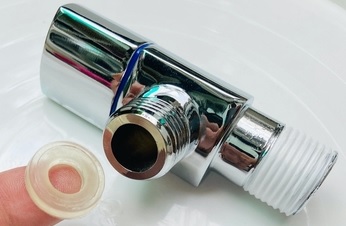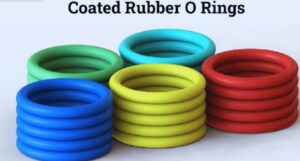The rubber O-ring is a mechanical gasket that comes with a design like a torus or donut that is used for static and dynamic applications, and parts move with each other and face friction. The main features of rubber O-rings are low cost, easy manufacturing, resistance to pressure, and easy installation. These rings are made with different rubber types like nitrile, Viton, and some synthetic rubber parts.
Different factors are involved for using accurate O-rings, such as hardness, abrasion resistance, heat resistance, and pressure tolerance. Here we will cover details for rubber O-rings and related factors. Let’s get started.
What is an O-ring?
- O-rings are circular elastic loops that provide seals for static and moving circuits. Their main work is to provide sealing between different designs, like pipes, tubes, pistons, and cylinders.
- According to use, O-rings are made with the use of different materials and have a flexible design.
- The main use of O-rings is in hydraulic and pneumatic systems and vehicle engine different parts, also for aviation parts. They maintain their shape and sealing feature with time after compression and decompression.
Static vs. dynamic O-rings
Static O-ring
- The static O-rings make a dependable and leak-proof seal in static components like pipes and fittings. For this ring, a groove is cut over a flat surface, and an O-ring of accurate dimensions and size is put in the groove. As a result, the O-ring compressed in position with another flat surface.
- When a connection is made, the material is static and the O-ring is static and does not move.

Dynamic O-ring
- The dynamic O-ring makes a seal between two surfaces with relative motion to each other. This ring is used with rotation like engines, hydraulic and pneumatic systems, and also for mechanical devices.
- As compared to static modules, dynamic O-rings work faster in constant motion. So it is good to lubricate the dynamic O-ring on a regular basis to provide good working.
- Dynamic rings are strong in nature, have a tough structure, and have resistance to friction and abrasion.
- There are two types of seals made with dynamic O-rings, like reciprocating and rotary seals.
Reciprocating seal:
- This type of seal is used for providing a reciprocating motion like a piston or cylinder. Reciprocating seals are made for providing a seal between two surfaces that have motion in opposite directions and handle friction and wear due to motion.
Rotary seal:
- This seal helps to maintain two surfaces that move each other, like in a shaft or bearing. Rotary seals are made to avoid fluid leakage and handling friction and wear due to rotation.
Rubber O-Ring Sizes and Dimensions
- O-rings have different shapes and sizes. Society of Automotive Engineers Aerospace Standard 568 defines inner diameter, cross section, and size codes for O-rings, parts of sealing devices, and also for thread tube fitting boss gaskets.
- Metric O-rings are explained with the internal dimension x the cross-section. The main part number of the metric O-ring—ID x CS [material & shore hardness] 2x1N70 shows this O-ring as 2 mm ID with a 1 mm cross section created with the use of Nitrile rubber that is 70 Sh.
- BS O-ring is the standard reference
What Materials Are Used for Rubber O-Rings?
O-rings are used for high-pressure applications where high pressure causes deformation of O-rings in the groove and makes smooth mechanical stress for the surface.
Different materials are used for rubber O-rings that are listed based on these features.
FKM (Viton)
- It provides chemical resistance. also has resistance for compression and mechanical features. Its working temperature range is -10°C and 120°C (-14-248°F).
- It has resistance for oils and solvents like aliphatic, halocarbons, acids, animals, etc. It has low resistance for high-temperature waters and steam since FKM swells for high temperatures.
- It is not good for polar solvents, esters, and ethers, or for glycol-based brake fluid.
EPDM
- The full form of RPDM is Ethylene Propylene Diene Monomer, and it is good for water, steam brake fluids, and acids for low values.
- It has resistance to weather influences and ozone.
- It shows low resistance for oil, grease, and solvents and is not good for aromatic hydrocarbons.
NBR (Nitrile Butadiene Rubber)
- It is also called acrylonitrile butadiene, or Bura-N, which has good resistance to compression, wear, and tearing.
- It is good for oily products and solvents. It shows sensitivity to weather influences, moderate temperature resistance, and is not good for brake fluid and polar solvents.
PTFE (Polytetrafluoroethylene)
- It has high resistance to chemicals and works for a temperature range of -20°C and 180°C (-4 – 356°F).
- PTFE rings are white in color and handle different materials like chemical acids, oils, and steam.
- PTFE comes with high resistance for abrasion and toughness and is difficult to compress, resulting in low sealing.
Silicone
- It has resistance to the bad effects of oils, heat, ozone, and solvents. It shows flexibility for low temperatures.
- It works in a temperature range of (-76 – 437°F), and a certain type can handle temperatures of -100°C to 300°C (-148 – 572°F).
Rubber O-Ring Types
Backup O-rings
- This ring, also called an anti-extrusion ring, is a special sealing component part of a high-temperature and pressure hydraulic system. It protects basic O-ring seals from damage that occurs as a result of pressurized fluid applying forces on the O-ring into the clearance gap.
- With working physical barrier control extrusion space, backup O-rings help basic seals to handle high pressure ratings and bad conditions.
- Different industries like oil and gas, chemical processing, and fluid power systems based on backup O-rings that provide reliable systems
Coated Rubber O Rings
Coated rubber O-rings are engineered to enhance performance by applying surface-coated films—such as PTFE (Teflon®), parylene, or silicone. This coating reduces installation friction, increases chemical compatibility, resists aggressive media, and provides color identification for different sealing applications. A coated O-ring is less likely to twist, tear, or suffer damage during assembly, resulting in improved durability, lifespan, and consistency of seal integrity. Such O-rings are preferred in food processing, pharmaceutical, aerospace, and high-purity fluid handling, where cleanliness and chemical resistance are paramount.
Encapsulated Rubber O-Rings
- Encapsulated rubber O-rings come with resilient cores that are made of silicon, closed in a jacket made with high-performance plastic, and also made with fluorinated ethylene propylene (FEP) or perfluoroalkoxy-copolymer (PFA).
- These advanced sealing features provide good resistance for corrosive chemicals, bad temperatures, and thermal cycling.
- PRF jackets provide inertness for larger types of chemicals and different temperatures for cryogenics at elevated levels. PFA jackets also provide high mechanical strength and resistance to cracks.
- Due to encapsulating jackets that can be damaged with basic motion, encapsulated O-rings are used for static sealing applications, like in pumps, valves, chemical processing, and semiconductors, and provide purity.
Hollow O-Rings
- Hollow rubber O-rings are made with a hollow cross section and are easily compressed and effective for conforming to irregularities, unlike standard O-rings.
- Its low-weight design is good for static, low-pressure, or vacuum-sealing applications, and it needs low forces for getting a strong seal, like for medical devices and delicate instruments.
- Hollow O-rings are not used for dynamic or high-pressure designs, since they do not handle repeated motion.
- They also provide flexible features of non-standard groove geometries.
Selecting Factor for O-Ring
Follow these points before getting O-rings.
O-ring material:
- Select O-rings based on materials for certain applications that demand things like pressure, temperature, and medium. If you do not know how to get an O-ring accurately, use a rubber indicator test for finding materials.
O-ring size:
- O-rings are defined by internal diameter, external diameter, and cross-section width. O-rings of standard size are not good for certain features; use custom-made O-rings.
hardness:
- The hardness of the O-ring defines its features for resistance to extrusion and deformation. Hardness is defined in durometer and has a range of 30 to 90. such as an O-ring with a durometer value of 60, which is soft compared to 70, and 90, which is harder than 70
International standards:
- O-rings are made with different international standards like ISO, DIN, and JIS. These standards make O-rings have smooth dimensions and material features and help to replace various widths for different uses. Some standard-specific rings are ISO 3601, DIN 3771, and JIS B2401.
Special cases:
- Different O-rings made for special connections and devices. SAE flange O-rings are made to fit in SAE flange connections used for hydraulic systems.
What are the advantages of rubber O-rings?
Different Sizes
- Rubber O-rings are in different sizes and shapes, like the ones you can use for pens to larger sizes for sealing pipelines. This feature helps to use them easily and process them. For small-sized and adaptable devices, rubber O-rings are the best option to use.
Hardness
- Hardness is an important factor; the durometer of the rubber of O-rings is set to get the required design for certain uses. Rubber O-rings are in a range of soft and hard that can handle low to high pressure applied and are good to use for different conditions.
Simple Structure
- Rubber O-ringsin standard and customized layouts are simple in design. Their simple features help to easily connect and replace in different applications.
Self-Seating
- Its simple design comes with a self-seat without using any tools that helps to use this module for low maintenance.
Tight Seal
- The basic working of a rubber O-ring is to make a tight and strong seal that avoids leakage. So these rings are commonly used.
Low cost
- Rubber O-rings are low-cost options and easy to access.
Applications
- The main uses of rubber O-rings are as.
- It is used in hydraulic systems, aircraft, and other parts.
- It is used in medical devices like pumps and valves.
- It is also used for pipes, valves, and plumbing parts to avoid leaks.
- It makes a seal between moving components like cylinder actuators and pistons.
- It is also part of the processing tools for avoiding contamination and providing hygiene.
- It is used for doors, windows, and containers to avoid

